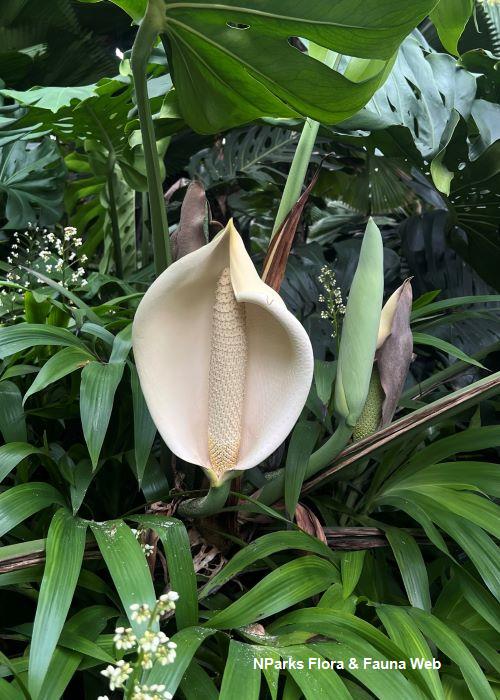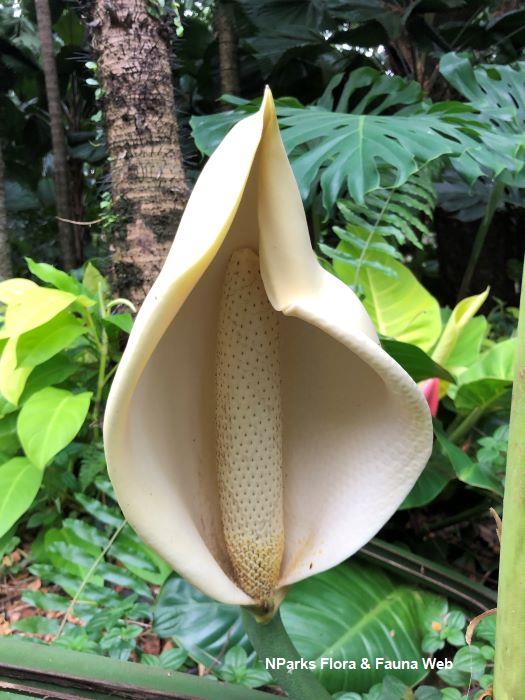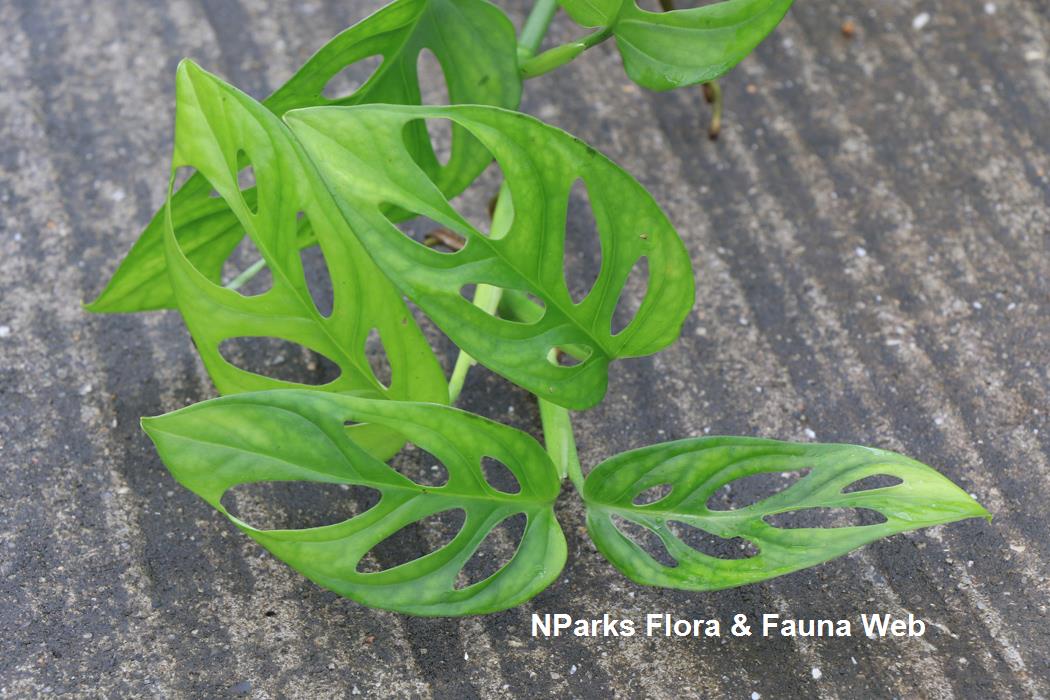.jpg)
Back
Monstera deliciosa Liebm.
| Family Name: | Araceae |
| Synonyms: | Monstera borsigiana K.Koch, Monstera deliciosa var. borsigiana (K.Koch) Engl., Philodendron pertusum Kunth & C.D.Bouché |
| Common Name: | Swiss-cheese Plant, Window Plant, Fruit Salad Plant, Ceriman |
Name
Classifications and Characteristics
| Plant Division | Angiosperms (Flowering Seed Plants) (Monocotyledon) |
|---|---|
| Plant Growth Form | Climber, Herbaceous Plant |
| Lifespan (in Singapore) | Perennial |
| Mode of Nutrition | Autotrophic |
Biogeography
| Native Distribution | Southern Mexico & Central America |
|---|---|
| Native Habitat | Terrestrial (Primary Rainforest) |
| Preferred Climate Zone | Tropical, Sub-Tropical / Monsoonal |
| Local Conservation Status | Non-native |
Description and Ethnobotany
| Growth Form | It is a climbing herbaceous plant that starts on the ground and grows upwards on tree trunks. |
|---|---|
| Roots | The roots are adventitious, sprouting from the nodes of the stem. These roots not only collect moisture and nutrients from rainwater and the surrounding environment but also aid in climbing. |
| Foliage | The leaves are leathery, mid to dark green, growing up to 90cm wide. The leaf blades are deeply lobed and fenestration (perforation). The petiole (leaf stalk) is thick, growing up to 1m long, lined with a winged fringe on either side. |
| Stems | The stems are thick and rarely branching. Leaf scars are very visible after the leaves are shed. |
| Flowers | The inflorescence is a long green spadix, subtended by an off-white spathe. The spadix can grow up to 30 cm long. |
| Fruit | The infructescence can be 30 cm long and 9 cm wide. Individual fruits appear as green, tightly-fitting hexagonal cells, each 1cm wide. As they ripen, the fruit turn yellowish and the edge loosens. |
| Cultivation | Smaller specimens of this species are popular as house plants as they are tolerant of indoor light levels (i.e., very bright—bright shade). Large specimens are used for outdoor landscaping, where they are allowed to sprawl on the ground or climb up very large trees. |
| Etymology | The scientific name Monstera deliciosa translates to 'Delicious Monstrosity' from Latin, referring to the edible fruits. These fruits can taste of pineapple, banana and/or jackfruit, earning it the common name 'Fruit Salad Plant'. The common names 'Swiss-cheese Plant' and 'Window Plant' are derived from the fenestrated leaves that allow light through like a window, although these names are sometimes shared with other Monstera species. |
| Ethnobotanical Uses | Edible Plant Parts : Edible Fruits Others: Only the fully ripened fruits should be eaten. The unripe fruits contain oxalate crystals, and these can irritate the mouth and throat, causing inflammation of the tissues. According to certain sources, some individuals have also displayed such symptoms after consuming the ripe fruits. If unsure of whether one will develop symptoms from eating the fruit, do not consume it. |
Landscaping Features
| Desirable Plant Features | Ornamental Foliage |
|---|---|
| Landscape Uses | Interiorscape/ Indoor Plant, Parks & Gardens |
| Thematic Landscaping | Naturalistic Garden |
| Usage Hazard - Cons | Irritant - Sap, Large Heavy Fruits, Toxic Upon Ingestion |
| Usage Hazard - Cons Remarks | The whole plant contains oxalate crystals, and the sap can irritate the mouth and throat if somehow ingested, causing inflammation of the tissues. Itchiness may also occur if the sap is exposed to the skin. |
Fauna, Pollination and Dispersal
| Pollination Method(s) | Biotic (Fauna) |
|---|---|
| Seed or Spore Dispersal | Biotic (Fauna) (Vertebrates (Other Mammal)) |
Plant Care and Propagation
| Light Preference | Semi-Shade, Full Shade |
|---|---|
| Water Preference | Moderate Water |
| Plant Growth Rate | Fast to Moderate |
| Rootzone Tolerance | Moist Soils, Well-Drained Soils, Fertile Loamy Soils, Disease / Pest Resistant, Easy to Grow |
| Planting Remarks | This species can be planted on the ground, where it will creep along the substrate to form a sizeable ground cover. It can climb up trees if it is allowed to, where it will develop into a very large and heavy climber. The clasping roots can leave marks on walls, so it should not be allowed to climb onto the walls as it can damage the paint works. |
| Pest(s) | Sucking Insects |
| Propagation Method | Stem Cutting |
Foliar
| Foliage Retention | Evergreen |
|---|---|
| Mature Foliage Colour(s) | Green, White |
| Mature Foliage Texture(s) | Leathery |
| Prominent Young Flush Colour(s) | Green - Light Green |
| Foliar Modification | Flower/Fruit Bract |
| Foliar Type | Simple / Unifoliate |
| Foliar Arrangement Along Stem | Alternate |
| Foliar Attachment to Stem | Petiolate |
| Foliar Shape(s) | Non-Palm Foliage (Obcordate, Cordate) |
| Foliar Venation | Pinnate / Net |
| Foliar Margin | Entire |
| Foliar Apex - Tip | Apiculate |
| Foliar Base | Cordate |
| Typical Foliar Area | Megaphyll (>1640.25cm2 ) |
Non - Foliar and Storage
| Stem Type & Modification | Herbaceous |
|---|---|
| Root Type | Underground (Fibrous Root), Aboveground (Aerial Root) |
Floral (Angiosperm)
| Flower & Plant Sexuality | Unisexual Flowers , Monoecious |
| Flower Colour(s) | Cream / Off-White, White |
|---|
| Flower Texture(s) | Leathery |
| Flower Grouping | Cluster / Inflorescence |
| Flower Location | Axillary |
| Flower Symmetry | Radial |
| Inflorescence Type | Spathe & Spadix |
| Flowering Habit | Polycarpic |
Fruit, Seed and Spore
| Mature Fruit Colour(s) | Green, Green - Bluish Green, Yellow / Golden |
|---|---|
| Mature Seed Colour(s) | Black |
| Seed Quantity Per Fruit | Few (1-5) |
Image Repository
Others
| Master ID | 157 |
|---|---|
| Species ID | 1453 |
| Flora Disclaimer | The information in this website has been compiled from reliable sources, such as reference works on medicinal plants. It is not a substitute for medical advice or treatment and NParks does not purport to provide any medical advice. Readers should always consult his/her physician before using or consuming a plant for medicinal purposes. |

.jpg)
.jpg)









.jpg)